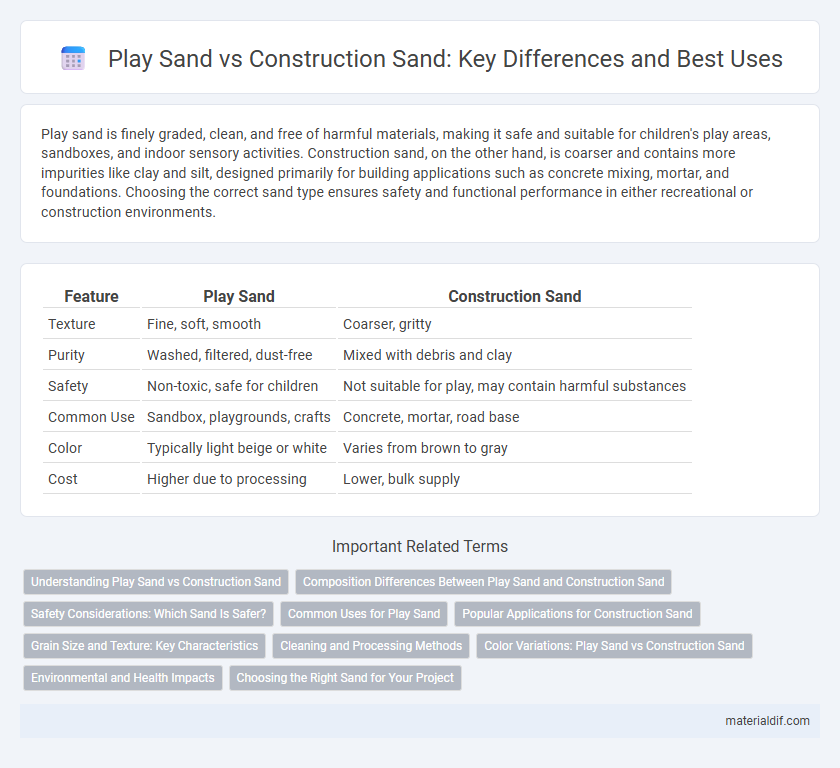Play sand is finely graded, clean, and free of harmful materials, making it safe and suitable for children's play areas, sandboxes, and indoor sensory activities. Construction sand, on the other hand, is coarser and contains more impurities like clay and silt, designed primarily for building applications such as concrete mixing, mortar, and foundations. Choosing the correct sand type ensures safety and functional performance in either recreational or construction environments.
Table of Comparison
| Feature | Play Sand | Construction Sand |
|---|---|---|
| Texture | Fine, soft, smooth | Coarser, gritty |
| Purity | Washed, filtered, dust-free | Mixed with debris and clay |
| Safety | Non-toxic, safe for children | Not suitable for play, may contain harmful substances |
| Common Use | Sandbox, playgrounds, crafts | Concrete, mortar, road base |
| Color | Typically light beige or white | Varies from brown to gray |
| Cost | Higher due to processing | Lower, bulk supply |
Understanding Play Sand vs Construction Sand
Play sand is finely screened and washed to ensure safety, softness, and cleanliness for children's recreational use, whereas construction sand is coarser with mixed particle sizes designed for structural strength and durability in building applications. Play sand typically has rounded grains to minimize scrapes and is free from harmful substances, while construction sand can include angular grains to improve binding with cement and other materials. Recognizing these differences is crucial to selecting the appropriate sand type for safe play environments or robust construction projects.
Composition Differences Between Play Sand and Construction Sand
Play sand primarily consists of finely graded, washed quartz sand particles that are free from contaminants, ensuring safety for children during play. Construction sand, also known as concrete sand, contains a mix of coarse and angular grains with impurities such as clay, silt, and organic matter, providing better bonding properties for building materials. The distinct particle size distribution and purity levels in play sand versus construction sand directly affect their suitability for recreational use or structural applications.
Safety Considerations: Which Sand Is Safer?
Play sand is specifically processed to be non-toxic and free of harmful contaminants, making it safer for children's recreational use. Construction sand, often containing sharp particles and potential industrial pollutants, poses health risks such as respiratory irritation or skin abrasions. Choosing play sand over construction sand significantly reduces the risk of exposure to hazardous materials during play.
Common Uses for Play Sand
Play sand is specifically designed for children's outdoor activities, offering a clean, fine texture ideal for sandboxes, playgrounds, and sensory play. It is free from harmful chemicals and debris, ensuring safe and non-toxic interaction for kids. Unlike construction sand, which is coarser and used primarily for concrete and masonry, play sand enhances tactile learning and creative play.
Popular Applications for Construction Sand
Construction sand is primarily used in concrete production, mortar mixing, and bricklaying due to its coarse texture and strength-enhancing properties. It serves as a key ingredient in paving projects, road base layers, and drainage systems, providing stability and durability. Unlike finer play sand, construction sand's angular grains improve bonding in structural applications.
Grain Size and Texture: Key Characteristics
Play sand features fine, uniform grains that are smooth and safe for children, promoting easy molding and minimal abrasiveness. Construction sand contains coarser, irregular grains that provide better compaction and strength for building projects. Grain size and texture differences directly affect usability, with play sand prioritizing softness and consistency, while construction sand emphasizes durability and stability.
Cleaning and Processing Methods
Play sand undergoes rigorous cleaning processes, including multiple washes and screenings to remove impurities, ensuring it is free of dust, clay, and organic materials for safe use in children's sandboxes. Construction sand typically requires less intensive cleaning; it is screened to eliminate oversized particles but may retain some natural minerals and fine silts acceptable for masonry and concrete applications. The processing of play sand emphasizes sanitation and uniform grain size, while construction sand processing prioritizes suitability for structural integrity and bonding in building projects.
Color Variations: Play Sand vs Construction Sand
Play sand often exhibits lighter, more consistent color tones such as pale beige or tan, which are intentionally processed to remove impurities and create a visually appealing, safe material for children. Construction sand typically ranges from yellowish-brown to darker browns and grays, reflecting its natural, unprocessed state that contains organic materials and minerals suited for structural use. These color variations highlight the purity and intended application differences between the finely screened, washed play sand and the coarser, unrefined construction sand.
Environmental and Health Impacts
Play sand is specifically engineered to be clean, non-toxic, and free of harmful contaminants, minimizing health risks such as respiratory issues and skin irritation in children. Construction sand often contains impurities like silica dust and heavy metals, which can pose significant environmental hazards and respiratory problems when inhaled over time. Choosing play sand reduces exposure to hazardous particles, promoting safer environmental and health outcomes, especially in residential and recreational settings.
Choosing the Right Sand for Your Project
Play sand is fine-grained, clean, and free from harmful materials, making it safe for children's play areas and sandboxes. Construction sand, often coarser with mixed grain sizes, provides better compaction and stability for concrete, mortar, and other building applications. Selecting the right sand depends on the project's purpose, prioritizing safety and texture for play areas versus strength and durability for construction.
Play sand vs Construction sand Infographic

 materialdif.com
materialdif.com